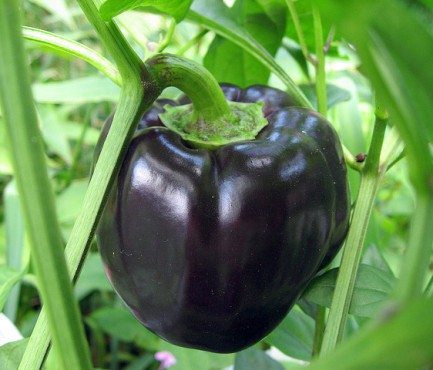The next big thing to grow in your garden should produce purple fruits, leaves, and roots. Purple food is the trendy thing to eat in 2017. It’s not just because it’s a unique color that pops on a plate, or stands out from the crowd in the produce aisle. Naturally blue and purple food is richer in health benefits than the same fruits and vegetables in other colors.

Planting purple vegetables, the darker the better, is growing natural medicine. (beautifulcataya, CC by 2.0)
Before you rush off to shop for seeds, note that they won’t all have the word ‘purple’ in their variety name. So, don’t pass over those seeds and plants with words that identify shades of ‘blue’ or ‘black’ in their name. It has to do with the pigment family, and the darker the hue, the better. It’s a sign that they’re loaded with curative, protective, and preventative powers. Purple vegetables and fruits have a lot of antioxidants, especially anthocyanins and phenolics.
Take black rice, for instance. It contains 6 times more antioxidants than brown and white, and outshines blueberries! It’s also higher in iron and vitamin E, along with other important benefits. A pricey oddity at the grocery store, so you might want to try growing your own. You’ll find packages of organic seed available on Etsy.
Naturally, if you’ve got room for a berry plot, you can grow a variety of dark blue or purple fruit every year from a single planting. Berries are rivaled only by spinach and kale in antioxidant levels. Blueberries, blackberries, black raspberries, acacia berries, boysenberries, loganberries… the list goes on. Not everyone has the right climate and/or soil to grow them all. Find out which ones will work in your yard, and some of them, like blueberries, do well in containers too.
Black grapes are another fruit to grow in a permanent placement. These offer all the great benefits of red grapes, including resveratal and quercitin, but also contain phenolic acids. And then there’s purple plums, and purple figs, providing even more fruity sources of important phytonutrients.

Growing Concord grapes is a sustainable source of powerful health benefits. (Wikipedia)
Potatoes come in purple too, not the skin, but the tuber’s meat. Purple Majesty Potatoes have super dark purple flesh that is surprisingly rich in vitamin C and phytonutrients. The Okinawan Potato is more commonly known as a purple sweet potato. It too packs more health benefits than its orange-fleshed cousin.
Asparagus is a delicious, early season treat that is super low maintenance. Purple Passion Asparagus has the deepest colored stems, because it’s especially rich in anthocyanins. Grow this perennial crop where they won’t be disturbed. Plant a 4′ wide row in the lawn, and once the last spears set seed, just mow it off. Once cut, the bed will become invisible, but you’ll be harvesting for many years.
Black and blue corn is normally a flour corn or popping corn, and requires a long season to reach the harvest stage. Both will be healthier eating than lighter or standard yellow varieties for snacking and cornmeal. If your climate is too short, start the seeds. With a home grain mill, you can make your own cornmeal. And standard popcorn is super healthy, and those dark varieties should be even richer in antioxidants. Learning how to make your own blue tortillas and tortilla chips might be fun. Betcha they’re better than store bought.
For all those who prefer their tomatoes to be red, it might be wise to take a more serious look at blue and black fruiting varieties. Yes, they taste different, but shouldn’t they? After all, due to the color of their skin, they have stronger or extra beneficial contents. Look for darkest skinned varieties, like Indigo Rose and Indigo Apple. However, you might want to avoid the Blueberries variety. They say it’s bitter and sour.

Blue fruiting Indigo Apple Tomatoes turns partially red when ripe. (Garden Diaries)
In the same plant family, Solinacea, there are purple peppers – both hot and sweet, purple tomatillos, and of course, eggplant. In fact, eggplant may be the most versatile purple food you can grow in the garden.
Broccoli is a powerhouse of beneficial properties, but purple broccoli has more antioxidants than green. And it’s best to microwave broccoli over boiling! It actually preserves and enhances its antioxidant compounds, according to a study done at Oxford.
Joining broccoli are other brassicas that offer even more purple food options. Purple cauliflower, for one. And let’s not forget purple kohlrabi, purple kale, purple brussel sprouts, and purple cabbages (head and Chinese types).
Have I overlooked any purple food? Oh my, yes… purple carrots, radishes, turnips, mustard, lettuces, and beans. And then there’s purple onions, leeks, garlic, basil, and beets.
Go forth and grow some purple 🙂
Source: The Telegraph. Top image courtesy of Cannundrums.